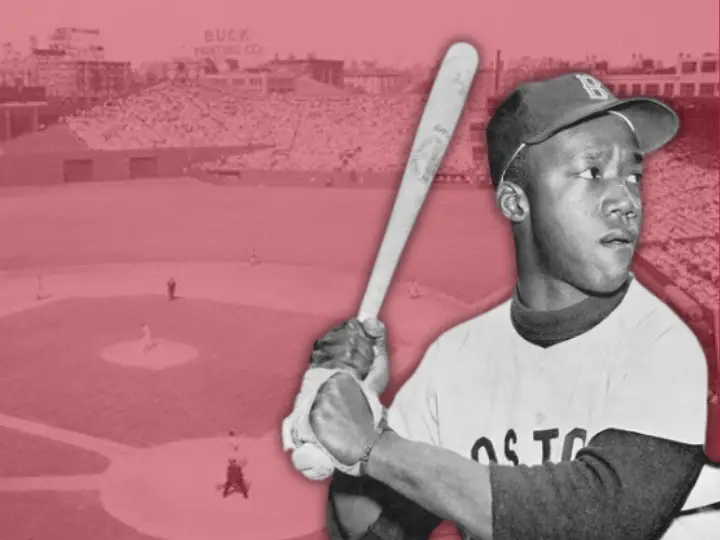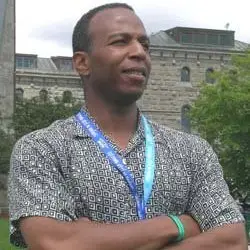As the Sox usher in spring with their first home stand of the season, a writer examines the hex that truly held back the team for decades.
Yes, the 21st-century Boston Red Sox beat a 20th-century curse. But the curse I’m calling out dates to 1945—not 1920, when the team sold Babe Ruth to the New York Yankees. Boston’s long slog without a World Series championship can be blamed on the socially hidebound mindset of ownership, not the Bambino trade. What the Red Sox finally overcame in 2004, when they swept the St. Louis Cardinals to win their first World Series in 86 years, was the Curse of Tom Yawkey.
Under Yawkey, who owned the team from 1933 until his death in 1976, the Red Sox were the last team in Major League Baseball to integrate, signing outfielder Pumpsie Green in 1959. As Dave Zirin wrote, “Green wasn’t just the team’s first black player—he was the first black employee of the entire organization, from the front office to the secretarial pool to the janitorial staff.”
This fact is often held up as an example of racism in Boston generally, but in fairness to the city, Yawkey and his front office were outliers. The National League Boston Braves integrated in 1950, and their owner rented Braves Field to local Black semipro teams such as the Boston Royal Giants when the Braves were on the road. The Celtics were the first NBA team to draft a Black player, in 1950. They were also the first to hire a Black head coach, and have had more Black head coaches than any league franchise. The AFL Patriots had Black players from the outset. And the Boston Bruins were the first team in the NHL to employ a Black player, Willie O’Ree, in 1958. These milestones show that Yawkey (a Detroit-born industrialist who owned plantations in South Carolina) was not an exemplar of his adopted town, or simply a product of his times—he could have made better choices.

In my lifetime, the three Blackest teams of the Yawkey era went to the wire in the World Series, losing in a Game 7 in 1967, 1975, and 1986. Despite Yawkey’s notorious hesitance to sign and retain Black and Afro-Latin talent, the ’67, ’75 and ’86 ball clubs, with their balances of speed, power hitting, and pitching, broke the mold and nearly won it all. The 2004 edition relied on this same formula, with Manny Ramirez and David Ortiz in the batting order, and Pedro Martinez on the mound. Pokey Reese, Orlando Cabrera and Dave Roberts also contributed.
Of course, Yawkey’s general managers did not assemble the 2004 roster; Theo Epstein did. Yawkey died the year after the thrilling yet heartbreaking ’75 Series. (And the year after his death, city officials renamed the section of Jersey Street bordering Fenway Park as Yawkey Way.) But a curse is a curse, and both the underlying and the surface reasons for the World Series drought—the repeated failures to close the deal—lie at the feet of Yawkey, and his succession of stubborn or ill-advised general managers.
This mismanagement reached a shameful and well documented low point in the 1940s, when the Red Sox staged a sham tryout for Negro League players Sam Jethroe, Jackie Robinson and Marvin Williams upon the insistence of Pittsburgh Courier journalist Wendell Smith and Boston city councilor Isadore Muchnick. Taking place on April 16, 1945, this was a “tryout” in name only: The team had no intention of signing the men, no matter how well they performed during the Fenway workout—which GM Joe Cronin didn’t even attend.
On April 15, 1947, Robinson broke into the majors with the Brooklyn Dodgers. He won National League Rookie of the Year that season. The crosstown Boston Braves signed the speedy Jethroe, who was NL Rookie of the Year in 1950.
Consider the longball-focused Red Sox of the early 1950s, with sluggers such as Ted Williams. The 1951 Sox won 87 games and the ’53 squad won 84. These weren’t bad ball teams—but the ’51 iteration would have been truly special if the hitters in the power part of the batting order—Williams, Vern Stephens and Walt Dropo—had Robinson and Jethroe on base before they came up to hit. Robinson’s and Jethroe’s quickness rattled pitchers, distracting them from the task at hand. Their base-running acumen enticed errant throws by catchers. Given that Billy Goodman, Dom DiMaggio, and Johnny Pesky were also on those teams—and that Ellis Kinder and Mel Parnell were strong pitchers—a racially integrated Boston Red Sox could have given the dynastic Yankees a run for their money in the 1950s. (Note, in those days before divisions or wild cards, the two teams with the most wins in each league advanced to the World Series.)
Williams must have known about Negro League talent, because in his 1966 acceptance speech for the Baseball Hall of Fame, out of nowhere he said, “And I hope that someday the names of Satchel Page and Josh Gibson in some way can be added as a symbol, the great Negro players that are not here, only because they were not given a chance.” The next year, Boston fielded an uncharacteristically diverse team. It made history.
The Impossible Dream
Boston finished in ninth place in 1966. Vegas oddsmakers set their chances of winning a pennant at 100–1 in 1967. During the ’67 season, Boston traded a young pitcher named Pete Magrini for 38-year-old New York catcher Elston Howard. In a way, this set a troubling and befuddling pattern of the Yawkey-era franchise: the tendency to acquire Black and Afro-Latin players after their productive primes. But though Howard was no longer much of a hitter, the Sox gained a clubhouse presence familiar with winning. Howard had been American League Most Valuable Player in 1963 (the first Black player ever awarded that title), and placed third in MVP voting in 1964.

“I wanted to finish my career with the Yankees,” Howard said. “I talked it over with my wife, my business associates and Tom Yawkey before deciding to go to Boston.” The Sox traded for Howard in hopes that the veteran of several Yankee World Series champion teams could guide their young pitching staff.
Howard only caught 42 games for Boston, batting just .147 with one home run and 11 runs batted in. But he still finished in the top 20 in AL MVP voting. Boston outfielder Tony Conigliaro said, “I don’t think I ever saw a pitcher shake off one of his signs. They had too much respect for him.” Moreover, in the ’67 Series, Howard’s bases-loaded single in the ninth inning of Game 5 gave Boston a 3–0 lead. They won that game 3–1, before going on to lose the Series in the seventh game.
Other key Black contributors in ’67 were rookie Reggie Smith, first baseman George Scott, third baseman Joe Foy, pitchers Jose Santiago and John Wyatt, and speedy reserve outfielder Jose Tartabull. They were the Blackest squad in team history. They made Fenway the place to be, forever boosting local demand for tickets. But what if they still had Earl Wilson?
Pitcher Earl Wilson debuted with Boston a week after Pumpsie Green racially integrated the franchise in 1959. Wilson posted a 1–1 mark that season, and was 3–2 in 1960. In ’62 he improved to 12–8. On June 26 of that season, he threw a no-hitter against the L.A. Angels, and hit a homer in the 2–0 victory (in the era before designated hitters).
At that point, Yawkey seemed a fan: The old man gave Wilson a $1,000 bonus, and said, “I am more excited now than I was during Mel Parnell’s no-hitter, as Wilson is just arriving at what could be a brilliant career.”
But in 1966, during spring training in Lakeland, Florida, Wilson and fellow pitcher Dennis Bennett went into a local bar called Cloud 9, where Wilson was refused service because he was Black. Wilson confided in Boston sportswriter Larry Claflin about the incident, but the story leaked to another journalist, who published it as an expose focusing on the fact that the players were out drinking—as if that were the scandal, not the fact that the bartender had hurled a racial slur at Wilson. On June 14, the Red Sox shipped Wilson and a Black substitute outfielder, Joe Christopher, to Detroit. Instead of being an integral part of the ’67 “Impossible Dream” team, Earl Wilson went 22–11 for a Tiger team which was itself in contention for a pennant until the final weekend of the season. It was his best season.
“Why couldn’t I just be Reggie Smith?”
Wedged between the 1970s dynasties of the Oakland A’s and the New York Yankees, the ’75 Red Sox won an AL pennant. Despite having dealt away Black stars Reggie Smith and George Scott, the team could still boast an inclusive roster, featuring Black and Latino talent like ace hurler Luis Tiant, pitcher Rogelio Moret, and young outfielders Jim Rice and Juan Beniquez.
Moret entered the Sox farm system in 1968 at age 18. His Winter League manager said Moret “can pitch a lot better than most of the junk the team has.” But despite their weaknesses on the mound, the big club dithered on promoting him, worried about his marijuana smoking. They finally brought him up in 1973.

In 1975, Moret went 14–3. On June 18, he beat Oakland 6–1, with 10 strikeouts. And yet, manager Darrell Johnson told the Boston Globe, “Roger will be in starting roles at times and he will be in the bullpen too.” Moret, a Puerto Rican whose name was not the Americanized “Roger,” was never happy with management, but publicly he acquiesced. “I want to be a winner and I can pitch anywhere against any team and I can beat them,” he said. “But if the manager points to the bullpen, then I’ll go there and win the game from the bullpen.”
Later, however, Moret accused Johnson of discriminating against Afro-Latin players and implied the team only kept Luis Tiant because he was a superstar. Moret also felt he should have started Game 3 of the ’75 World Series.
The glory of the 1975 World Series team can’t be discussed without the context of what could have been. Reggie Smith had been a solid center fielder, and he hit 30 home runs for Boston in 1971. But Smith was vocal about his unhappiness in Boston, garnering the team negative press. For example, during spring training in Winter Haven, Florida, Smith spoke out about the Black players not receiving free passes to the local Elks lodge, a popular post-game hangout, as the white players had.
So the Sox traded Smith to St. Louis after 1973. He spent 1975 batting .302 for the Cardinals, with 19 homers and 76 runs batted in, and earning a Gold Glove at center field. Smith had some complaints about the St. Louis press, lamenting, “I just got awfully tired of people saying that I never lived up to my potential. Everybody expected me to be a Willie Mays or a Hank Aaron. Why couldn’t I just be Reggie Smith?”
But just being Reggie Smith was pretty damned good. Imagine if he had stayed in Boston. Sure, Smith played the same position as ’75 A.L. Rookie of the Year and MVP Fred Lynn. But Smitty could also play right field. He was a Gold Glover in both ’75 and ’76 with St. Louis. As late as 1977, Smith batted .307 with 32 homers and 87 RBI for the pennant-winning L.A. Dodgers. He led the NL in on-base percentage, and finished fourth in MVP balloting. He was fourth in voting again in 1978—the season Boston lost a one-game playoff to the Yankees. Those Boston teams could have used Smith as a DH, or outfield mate of Lynn’s (and Rice’s).
Filing suit
Boston had also traded away Tommy Harper, who stole 54 bases (leading the league) and drove in 71 runs for the 1973 team. Behind the scenes, Harper’s multiple tenures with the Sox reveal as much about the organization as perhaps any non-white player. Harper had never been vocal like Smith. After he retired from playing in 1976, Harper approached Boston about minor league coaching work. The team didn’t hire him, but the Yankees did.
By 1977, the Massachusetts Commission Against Discrimination (MCAD) settled a discrimination suit against the Red Sox. Only then did the front office reach out to Harper about a job. New York was paying him $25,000 a year, but would not release him from the third year of his New York contract. So in 1980, Boston offered Harper a $40,000 post combining first base coaching and minor league instructional work with—unbeknownst to him—a PR role: When Harper reported to work, a journalist surprised him by asking what he thought of his new role as the ball club’s affirmative action officer. The team had never discussed that responsibility with Harper.
In the 1980s, white players at Sox spring training were still receiving free passes to the segregated Elks Club in Winter Haven. After Harper broke his silence on the issue, the team fired him. In 1986, Harper filed state and federal discrimination complaints. The U.S. Equal Employment Opportunity Commission ordered the Red Sox to pay Harper a financial settlement, finding that the team had “created and perpetuated a working environment that was hostile to minorities.”
The fact that the MCAD ruled against the team in ’77, leading to Harper’s hiring, and that Harper then won his own EEOC case in ’86, is proof positive of the organization’s biased judgement over the decades.

The same year Harper won his suit, management fielded a team that had a lot in common with their ’67 and ’75 forerunners. The 1986 Red Sox used a combination of power, defense and pitching to win an AL pennant. And for a Boston team, they had a lot of Black and Afro-Latin talent: Jim Rice, Tony Armas, Don Baylor, Dave Henderson, and enigmatic pitcher Dennis “Oil Can” Boyd.
But this team, too, suffered from the lingering legacy of Yawkey. Boyd won 16 games for the ’86 club, and he was scheduled to start Game 7 of the World Series. However, when the game was rained out, manager John McNamara chose Bruce Hurst to start the postponed game, even though Boyd was available and rested. The snub prompted Boyd to get drunk in the clubhouse. The following year, an alleged police encounter resulted in the arm injury that hampered Boyd’s performance that season. Inconsistent afterwards, he was out of the majors by 1992.
What’s in a name?
In 2004, I interviewed 1970s Sox pitcher Bill Lee. I asked him about the ’04 World Series win, and the supposed Curse of the Bambino. Lee said, “It’s strange that little Dave Roberts, a second baseman, changed the pivotal [ALCS playoff] game. This for a team that tried to win without speed, defense or pitching for so long. That turned down Jackie Robinson. . . . Tom Yawkey built teams around the long ball.
“I’ll never forget [ALCS Game 4],” Lee went on, referring to the moment when the Sox, down 0–3 in the series, started to turn the tide against the Yankees with a base stolen by pinch runner Roberts. “A fan was yelling at the Sox skipper in a Jamaican accent, ‘Put the jumpah [pinch runner] in! Put the jumpah in!’ But Posada made a great throw on that [Roberts] play; maybe an inch to the third base side. Then we get a base hit up the middle, we’re back in it.”
On April 26, 2018, the Boston Public Improvement Commission unanimously approved the name change of Yawkey Way back to Jersey Street. “The undeniable and regrettable history of the Red Sox make it difficult to continue to give prominence to a symbol associated with an era marred by racial discrimination,” said Red Sox attorney David Friedman, at a hearing before the Improvement Commission.
Yawkey was not without defenders. Even Reggie Smith, perhaps having mellowed over the years, told Globe sports columnist Dan Shaughnessy, “Tom Yawkey treated me very fairly. I had conversations with him about the reputation that he had and the Red Sox had during the time I was there. He wanted to make sure that he had a good team and he wanted the best players he could possibly get. . . . I was treated very fairly and I know that when I left Boston I was the highest-paid African-American player that he had, and I respect him for it.”
The street name change was made official on May 3, 2018, nearly 100 years after the Red Sox defeated the Cubs for their last World Series title of the 20th century.
“The Curse of the Bambino” served as a convenient, woe-is-us, superstitious excuse for futility for fans across six New England states for eight decades. The reality was more complicated.






